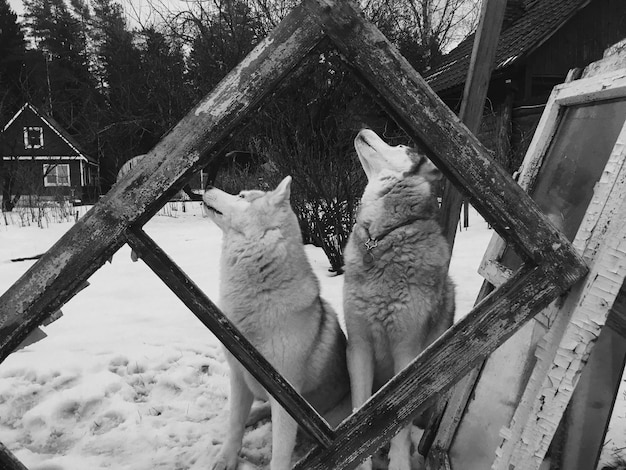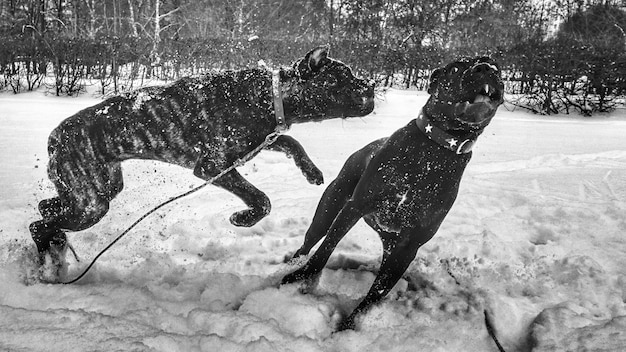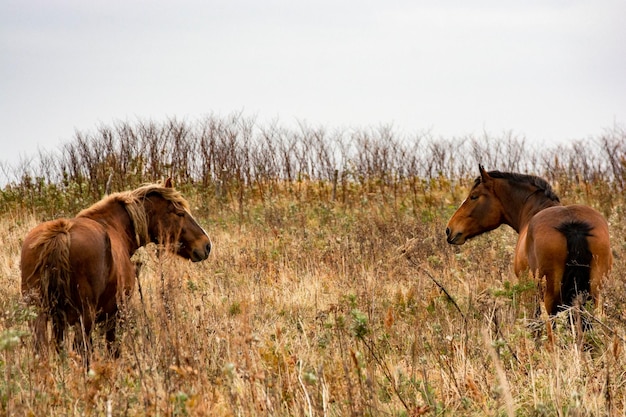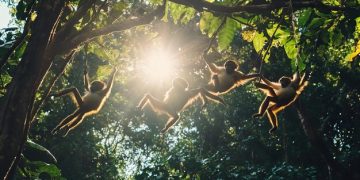Domestication’s Impact: Wild vs. Domestic Animal Behavior

The effects of domestication on animal behavior are profound, leading to significant differences in social structures, communication, cognitive abilities, and responses to environmental stimuli when comparing wild and domesticated species.
The fascinating world of animal behavior is significantly shaped by domestication. The effects of domestication on animal behavior: a comparison of wild vs. domesticated species reveals key insights into how selective breeding and human interaction have altered the natural instincts and behaviors of various animals.
Understanding Domestication and Its Evolutionary Context
Domestication is a transformative process where wild animals are selectively bred over generations to live closely with humans. This process profoundly influences the genetic makeup and, consequently, the behavior of these animals. Let’s delve into the history and evolutionary context of domestication to understand its impact.
The History Of Domestication
Domestication has ancient roots, dating back thousands of years. The earliest domesticated animals, such as dogs, sheep, and goats, were integrated into human societies for various purposes, including companionship, food, and labor. This long history provides a rich timeline to study the gradual changes in behavior.
Evolutionary Context
From an evolutionary perspective, domestication represents a unique form of artificial selection. Unlike natural selection, where traits that enhance survival and reproduction in the wild are favored, domestication involves humans selecting traits that are beneficial to them. This has led to significant divergence in behavioral traits between wild and domesticated animals.

Key aspects of this context include:
- Selective Breeding: Humans choose specific traits, altering the genetic makeup of the species.
- Environmental Adaptation: Domesticated animals adapt to human-modified environments.
- Behavioral Changes: Instincts are modified, leading to new social structures and interactions.
In essence, domestication reshapes an animal’s evolutionary trajectory, leading to a suite of behavioral changes that are distinct from their wild counterparts. These changes often make domesticated animals more amenable to living alongside humans, but they also come with trade-offs in terms of natural behaviors and survival skills.
Social Behavior: Packs vs. Households
Social behavior is one of the most noticeable areas of divergence between wild and domesticated animals. Wild animals often live in complex social structures with clearly defined hierarchies, while domesticated animals have adapted to living in human households. These different environments have shaped their social interactions and communication styles.
Wild Animal Social Structures
In the wild, many animals, like wolves and lions, live in packs or prides that are crucial for survival. These groups provide protection, cooperative hunting, and shared childcare. The social hierarchy within these groups dictates access to resources and mates.
Domesticated Animal Social Structures
Domesticated animals, such as dogs and cats, have adapted to living in human households, which offer a vastly different social environment. Here, they often form strong bonds with humans, viewing them as part of their social group. This shift has led to changes in their natural social behaviors.
Key differences include:
- Hierarchy: Wild animals maintain strict hierarchies; domesticated animals adapt to human-led structures.
- Communication: Wild animals use complex vocalizations and body language; domesticated animals learn to respond to human cues.
- Bonding: Wild animals bond with their pack; domesticated animals bond with humans.
The shift from complex wild social structures to human-centered dynamics illustrates the profound adaptability of domesticated animals. While they may retain some natural instincts, their social behaviors are significantly influenced by their interactions with humans, leading to unique social dynamics within the household environment.

Communication Differences: Signals and Cues
Communication is vital for survival and social interaction among animals. Domestication has significantly altered both the modes and effectiveness of communication. Wild animals rely on a diverse array of signals, whereas domesticated animals have adapted to human-centric communication cues.
Communication In Wild Animals
Wild animals use a combination of vocalizations, body language, scent marking, and visual cues to communicate with each other. These signals convey essential information about territory, mating, danger, and social status. Effective communication is critical for group cohesion and survival in the wild.
Communication In Domesticated Animals
Domesticated animals, on the other hand, have evolved to respond to human communication cues. This includes understanding verbal commands, gestures, and even emotional tones. While they still retain some natural communication methods, their repertoire has expanded to include human-directed signals.
Notable communication adaptations include:
- Vocalizations: Wild animals use a broad range of calls; domesticated animals adapt specific sounds for human interaction.
- Body Language: Wild animals convey intricate social messages; domesticated animals rely on simpler, human-readable cues.
- Scent Marking: Wild animals establish territory; domesticated animals use marking for comfort and security.
The domestication process has effectively bridged the communication gap between humans and animals, enhancing cooperation and understanding. However, this adaptation also means that domesticated animals may sometimes struggle to effectively communicate with their own species, especially if they have been raised primarily in human environments.
Cognitive Abilities and Problem-Solving
Cognitive abilities play a crucial role in an animal’s ability to navigate its environment, solve problems, and adapt to new situations. The domestication process has had a profound impact on these cognitive skills, often leading to both gains and losses when comparing wild and domesticated species.
Cognitive Skills In Wild Animals
Wild animals face a multitude of challenges that require sophisticated cognitive abilities. They must learn to find food, avoid predators, navigate complex terrains, and interact with their social group. Problem-solving skills are particularly important for survival in unpredictable environments.
Cognitive Skills In Domesticated Animals
Domesticated animals, living in human-controlled environments, often face fewer of these challenges. Their food is provided, shelter is secured, and dangers are minimized. This reduced need for independent problem-solving has led to some cognitive abilities becoming less developed, while others have adapted to human interaction.
The Trade-offs
The trade-offs include:
- Wild animals: excel in independent problem-solving and survival skills.
- Domesticated animals: adapt cognitive abilities to human-guided tasks.
- Domestication: has both promoted and reduced various cognitive abilities.
Despite these trade-offs, domesticated animals have shown remarkable adaptability. They can learn complex tasks, follow human instructions, and even exhibit signs of empathy. The domestication process has reshaped their cognitive landscape, highlighting the dynamic interplay between environment and intellect.
Fear, Aggression, and Behavioral Responses
Fear, aggression, and specific behavioral responses are critical for survival in the wild, but domestication has profoundly altered these instincts. Understanding how these changes manifest is key to grasping the effect of domestication on animal behavior. Let’s look at both wild and domesticated populations.
Fear and Aggression In Wild Animals
Wild animals rely on fear and aggression as primary defense mechanisms. Fear drives them to avoid danger, while aggression is used to protect themselves, their territory, and their offspring. These responses are finely tuned to ensure survival in harsh environments.
Fear and Aggression In Domesticated Animals
Domesticated animals, who live in controlled environments, typically exhibit reduced levels of fear and aggression compared to their wild counterparts. Selective breeding has favored animals that are more docile and less likely to exhibit aggressive behaviors. This shift makes them easier to manage and interact with.
Domestication alters:
- Fear Response: Wild animals have high reactivity to threats; domesticated animals show reduced fear.
- Aggression: Wild animals use aggression for survival; domesticated animals display lower aggression levels.
- Overall behavior: Wild animals require self-reliance strategies; domesticated animals adapt to human guidance.
The behavioral changes are not without potential drawbacks. Reduced fear and aggression can make domesticated animals more vulnerable to threats if they are ever placed in a wild environment. However, in human-dominated environments, these traits contribute to a safer and more harmonious coexistence.
Genetic and Environmental Influences
The behavior of an animal is influenced by a complex interplay of genetic and environmental factors. The genetic makeup passed down from ancestors determines the initial predispositions, while environmental experiences shape how these traits are expressed. Domestication adds another layer of complexity by altering both genetic selection and the environmental conditions in which animals live.
Genetic Factors
Domestication involves selective breeding, which changes the genetic makeup of animals over generations. This process can lead to the amplification of certain behavioral traits while diminishing others.
Environmental Factors
The environment in which an animal grows and lives also dramatically shapes its behavior. Domesticated animals live in human-controlled environments, which offer vastly different stimuli and challenges compared to the wilderness.
Key factors influencing behavior include:
- Domestication: alters gene pool and changes environmental context.
- Genetics: establishes behavior predispositions passed down through generations.
- Environment: triggers the expression of behavioral traits.
The interaction between genetics and environment is dynamic. While genes provide a blueprint, the environment determines how that blueprint is executed. Domesticated animals provide a unique example of how these factors can be intentionally manipulated, leading to significant changes in behavior that benefit both animals and humans.
| Key Point | Brief Description |
|---|---|
| 🏡 Social Behavior | Domesticated animals adapt to human households, unlike structured wild packs. |
| 🗣️ Communication | Domesticated animals respond to human cues; wild animals use varied signals. |
| 🧠 Cognitive Skills | Wild animals excel in problem-solving; domesticated adapt to human tasks. |
| 🛡️ Fear & Aggression | Domesticated animals show reduced fear and aggression compared to wild. |
Frequently Asked Questions
▼
Domestication is a selective process where animals are bred over generations to live closely with humans, altering their genetic traits and behaviors to better suit human needs and environments.
▼
Wild animals often live in structured packs with strict hierarchies, while domesticated animals adapt to human-led social structures within households, forming bonds with humans.
▼
Wild animals use various signals like vocalizations and body language, while domesticated animals evolve to respond to human cues, verbal commands, and emotional tones.
▼
Domestication can lead to trade-offs in cognitive skills; wild animals excel in independent problem-solving, while domesticated animals adapt to tasks guided by humans.
▼
In wild animals, fear and aggression are primary defenses; domesticated animals typically exhibit lower levels of these behaviors due to selective breeding for docility.
Conclusion
In summary, the fascinating study of how domestication affects animal behavior reveals significant differences between wild and domesticated species. These insights benefit anyone interested in animal behavior, offering a deeper understanding of animal behavior and its implications.





